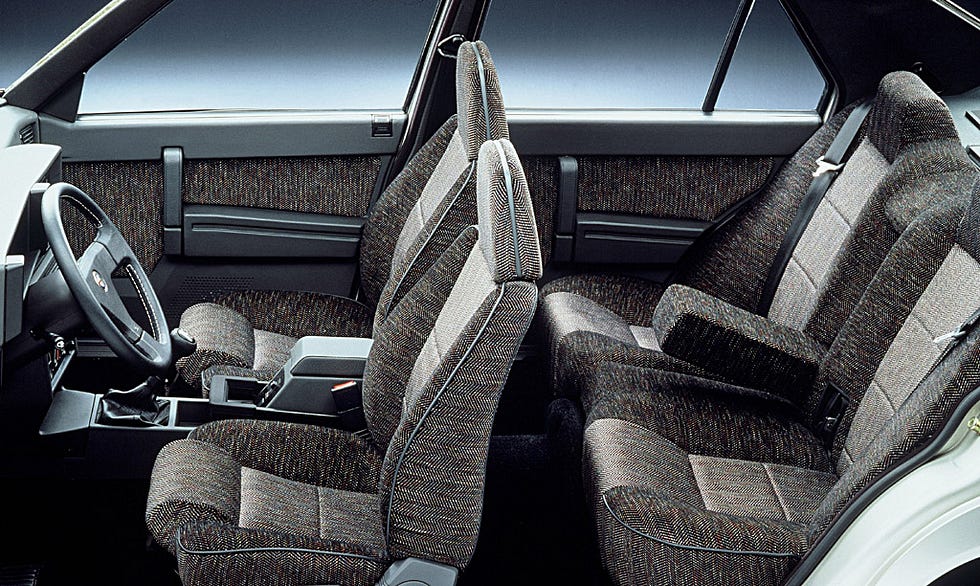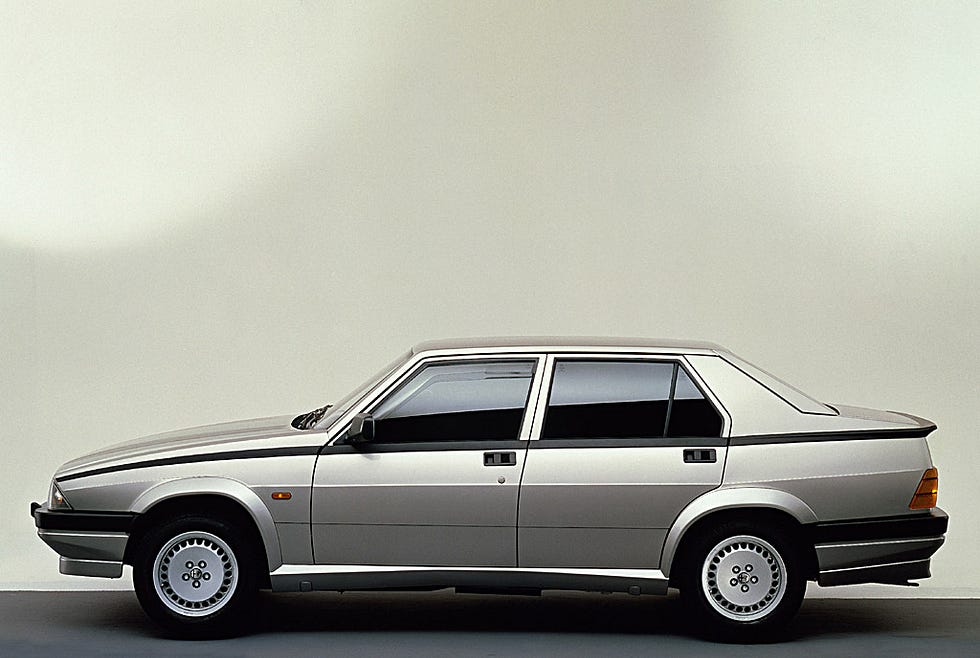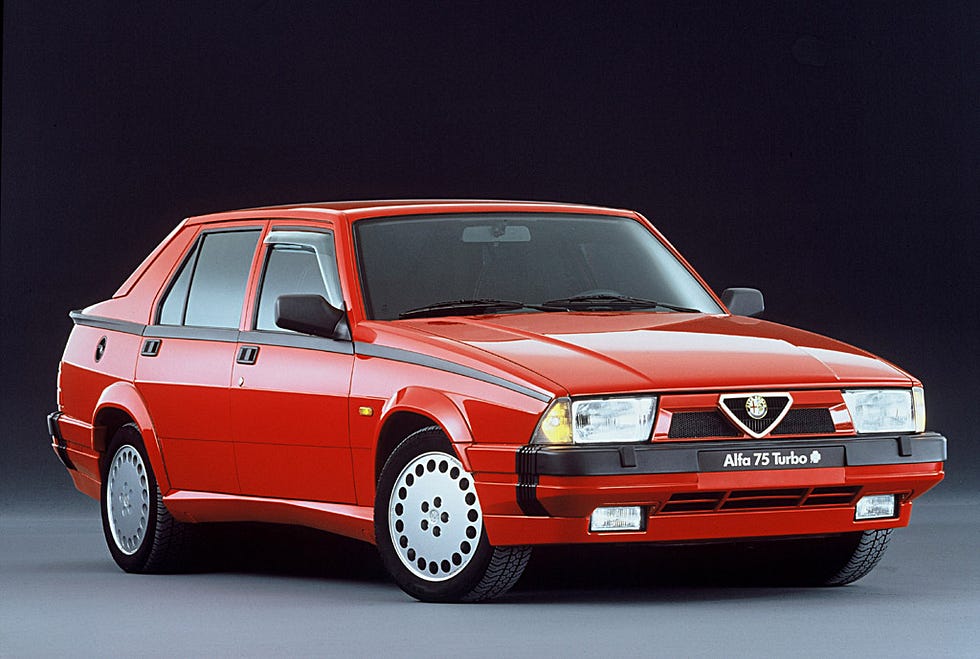The Story Of The Unforgettable Alfa 75 / Milano
Despite having been designed on a shoestring budget, the Alfa 75 ended up being much more than the sum of its parts, and it’s now gaining favor in the collectors’ car market as the last “classic” Alfa Romeo. Here’s its story.
アルファロメオ アルファ75ターボ「アメリカ」(画像:Stellantis Media Siteより)
It would be an understatement to say that the people in charge at Alfa Romeo in the early 1980s had the cards stacked against them. Crippled by an unsustainable debt burden, Alfa desperately needed new models to lure buyers into its showrooms but lacked the resources to fund them. However, what Alfa Romeo's people had in spades was ingenuity, and the beloved Alfa 75 undoubtedly is a testament to that
限られた予算で設計されたにもかかわらず、アルファロメオ最後のクラシックカーとして、コレクターズカー市場でも人気を博しているアルファ75。そのストーリーを紹介しよう。
1980年代初頭、アルファロメオの経営陣は不利な状況に立たされたといっても過言ではない。負債を抱えていたアルファは、バイヤーをショールームに呼び込むためのニューモデルが必要だったが、そのための資金が不足していたのだ。しかし、アルファロメオの人々が持っていたのは創意工夫であり、愛すべきアルファ75は間違いなくその証である。
Little to celebrate
Launched on May 17, 1985, the Alfa 75 owed its name to the seventy-fifth anniversary of the company's foundation in Milan and, although there was little to celebrate about the state of the company, the model went on to become a success, at least in its home market of Italy.

1985年式アルファ75 2.5 V6(画像はステランティス・メディア・サイトより)
Due to the aforementioned budgetary constraints, the Alfa 75 wasn't an all-new model but rather a comprehensive evolution of the Giulietta it replaced, of which maintained the running gear and most of the body structure, doors included.
However, the creatives at Alfa Romeo's design center, headed by Ermanno Cressoni, cleverly disguised the carry-over doors via a plastic molding that ran around the car and emphasized its dynamic wedge profile, becoming its main styling feature.

アルファ 75 ターボ・アメリカのインテリア(画像:Stellantis Media Siteより)
The Alfa 75's interior was a completely new design, and the 60mm longer rear overhang provided ample luggage capacity compared to its predecessor.
祝杯を上げるには程遠い
1985年5月17日に発表されたアルファ75は、ミラノでの創業75周年にちなんで名づけられた。
アルファ75は、前述の予算上の制約から、新型車ではなく、ジュリエッタを全面的に進化させたモデルで、走行装置やドアを含むボディ構造の大部分は維持された。
しかし、エルマンノ・クレッソーニ率いるアルファロメオのデザインセンターのクリエイターたちは、キャリーオーバーされたドアをプラスチック製のモールディングで巧みに隠し、クルマを一周させてダイナミックなウェッジプロファイルを強調し、このモデルの最大のスタイリングフィーチャーとしたのである。
インテリアはまったく新しいデザインで、リアオーバーハングが60mm延長されたことにより、先代モデルよりも十分なラゲッジ容量が確保された。
The power of tradition
Under the hood of the Alfa 75, no surprises awaited the traditional Alfa Romeo customer, once again presented with the company's long-established range of twin-cam inline-4 engines between 1.6 and 2 liters of displacement fed by two side-draft carburetors.
But the uncontested peak of the range was, of course, the Alfa 75 2.5 V6, equipped with the same sweet, melodious fuel-injected V6 engine already on use in the GTV6 coupès. Like those, the 75 V6 also needed its specific bonnet pressing to clear the tall engine plenum.
伝統のパワー
アルファロメオの伝統である、排気量1.6~2リッターのツインカム直列4気筒エンジンとサイドドラフトキャブレターが搭載されたアルファ75のボンネットの下には、何のサプライズもなかった。
しかし、その頂点に立つのは、もちろんアルファ75 2.5 V6である。このエンジンは、すでにGTV6クーペに搭載されていたものと同じ、甘美でメロディアスな噴射式のV6エンジンを搭載していた。75 V6もまた、背の高いエンジン・プレナムをクリアするために、ボンネットに専用のプレス加工が施されていた。
Turbo boost
The first significant technical development in the Alfa 75's history was the launch of the 1.8 Turbo: not the fastest, but certainly the sportiest version of the 75, destined to replace the GTV6 in the European Touring Car racing scene.
Moreover, it was Alfa Romeo's first turbocharged model to be mass-produced in the Arese factory, as opposed to the low-volume specials made by Autodelta over the previous years.
The 1.8 liters inline-4 twin-cam made 155HP at 5800Rpm thanks to a Garrett T3 turbocharger feeding intake air at a maximum pressure of 0.9 bar through an intercooler.
ターボ・ブースト
アルファ75の歴史において、最初の重要な技術開発は1.8ターボの登場だった。最速ではないが、75の中で最もスポーティなバージョンであることは間違いなく、欧州ツーリングカーレースにおいてGTV6に代わる存在となるはずであった。
しかも、それまでのオートデルタによる少量生産のスペシャルモデルとは異なり、アルファロメオ初のアレーゼ工場での大量生産によるターボエンジン搭載モデルであった。
1.8リッター直列4気筒ツインカムは、インタークーラーを介して最高圧力0.9barの吸気を行うギャレットT3ターボチャージャーにより、155HP/5800rpmを発生した。
アルファ75ターボは、V6よりも0.5秒速く、カラーリングされたバンパーやホイールアーチエクステンションなど、控えめな外観を持つ。
Up to eleven
Anything but subtle was, instead, the Alfa 75 Turbo Evoluzione, a homologation special manufactured in 500 examples over 1987, all painted in Rosso Alfa.

アルファ 75 ターボ エボルツィオーネ(画像:ステランティス・メディア・サイトより)
Its aero package was worth a two-point reduction in Cd, and the suspensions received thicker anti-roll bars, revised geometries, and reinforced hubs.
To comply with sporting regulations, the engine's displacement was slightly reduced from the original 1779cc to 1762cc to stay within the three-liters category once the 1.7 coefficient for turbo engines was applied. Despite this, Alfa Romeo likely underrated the engine's power output at 155HP, given the higher boost pressure and redesigned exhaust manifold exclusive to this now highly sought-after version.
Although it was half a second faster than the V6 in the classic naught-to-sixty sprint, the Alfa 75 turbo was remarkably understated in its appearance, with color-coded bumpers and subtle wheel arch extensions.
最大11台
アルファ75ターボ・エボルツィオーネは、1987年に500台が製造されたホモロゲーションモデルで、全車ロッソ・アルファで塗装された。
エアロパッケージはCd値を2ポイント下げ、サスペンションは太いアンチロールバーと形状の変更、ハブの強化が施された。
スポーツ走行規制に対応するため、エンジン排気量はオリジナルの1779ccから1762ccへとわずかに縮小され、ターボエンジンの係数1.7が適用されて3リッターの範疇に収まるようになった。しかし、ブースト圧を高め、エキゾーストマニホールドの設計を変更するなどして、アルファロメオは155馬力と過小評価したようである。
Twin Spark
February of 1987 saw the introduction of perhaps the most important version of the 75, the 2.0 liters Twin Spark.

アルファ 75 ツインスパーク(画像はステランティス・メディアサイトより)
Rated at 148HP at 5800Rpm, the Twin Spark engine offered a level of performance right at the top of the two-liter class, thanks to its new and innovative cylinder head design.
Not only the two valves per cylinder were inclined at a much tighter angle, which allowed for better thermal efficiency and a straighter inlet port, but the two spark plugs on the side of the combustion chamber left space for an intake valve of larger diameter. The package was completed by Alfa's variable valve timing system and Bosch Motronic ME7 electronic fuel injection.
This new level of performance, together with a limited-slip differential as standard and some well-judged exterior design tweaks, transformed the 75's previously rather staid image, and the TS remained very popular in Italy until the model's demise.
Contemporarily to the 2.0 TS, Alfa Romeo also presented the range-topping 75 3.0 V6 "America," with exterior and interior specifications close to the models sold on the other side of the Atlantic. Later the same year, the so-called "America" appearance package, with the more prominent bumpers, was extended to the 1.8 Turbo as well.
ツインスパーク
1987年2月、75の最も重要なバージョンである2.0リッターのツインスパークが発表された。
148馬力/5800rpmのツインスパーク・エンジンは、革新的なシリンダーヘッド設計により、2リッター・クラスのトップレベルの性能を発揮した。
1気筒あたり2つのバルブをより狭い角度で傾斜させることで熱効率を高め、吸気ポートをストレートにしただけでなく、燃焼室のサイドに2つのスパークプラグを配置し、大径の吸気バルブを搭載するスペースを確保した。このパッケージは、アルファの可変バルブタイミングシステムとボッシュのモトロニックME7電子燃料噴射装置によって完成された。
この新しいレベルのパフォーマンスと、リミテッド・スリップ・デフの標準装備、そして適切なエクステリアデザインの調整により、それまで地味だった75のイメージが一変し、TSはモデル消滅までイタリアで高い人気を維持した。
2.0 TSと同時期に、アルファロメオは75の最上級モデルである3.0 V6 "アメリカ "を発表し、大西洋の反対側で販売されているモデルに近いエクステリアとインテリアの仕様とした。同年末には、1.8ターボにもバンパーを強調した「アメリカ」アピアランス・パッケージが追加された。
Coming to America
The 1980s saw the affirmation of European sports-luxury saloons in the USA, and to win Alfa Romeo a slice of that potentially lucrative pie, the Alfa 75 became the Milano.
The Milano was, in essence, a 75 2.5 V6 quite extensively modified to comply with federal legislation, which, at the time, was considerably more prescriptive than the European one.

アルファロメオ・ミラノ(画像はウィキメディア・コモンズより)
Built on a specific production line in the Arese factory, the Milano had more robust hinges to support the doors, made heavier by the side impact bars. The fuel tank was larger and repositioned in a more secure location between the rear seat and the boot, whose capacity decreased quite markedly as a result.
The larger bumpers complied with the "5 Mph" impact requirements, and the bonnet's hinges and catches were redesigned to eliminate the risk of intrusion into the passenger compartment during a crash.
Sold between June 1986 and August 1989, the Milano was initially offered in three trim levels: Silver, Gold, and Platinum. The sportier Milano Verde, equipped with the new 3.0 liters V6, joined the range in late 1987.
アメリカへの進出
1980年代、アメリカではヨーロッパのスポーツラグジュアリーサルーンが認められ、アルファロメオはその潜在的な利益を得るために、アルファ75はミラノとなった。
ミラノは、75の2.5V6を大幅に改良したもので、当時、欧州よりもかなり厳格だった連邦法に準拠したモデルである。
アレーゼ工場の専用ラインで生産されたミラノは、サイド・インパクト・バーにより重くなったドアを支えるヒンジがより強固になった。燃料タンクは大きくなり、後席とトランクの間の安全な場所に移されたが、その結果、容量はかなり減少した。
バンパーを大型化して時速5マイルに対応させ、ボンネットのヒンジとキャッチのデザインを変更し、衝突時に客室内に侵入する危険性を排除した。
1986年6月から1989年8月まで販売されたミラノは、当初3つのトリムレベルで提供された。シルバー、ゴールド、プラチナの3種類。1987年末には、3.0リッターV6を搭載したスポーティなミラノ・ヴェルデがラインナップに加えられた。
Cleaning up
October of 1988 saw the launch of the revised Alfa 75 range, easily recognizable by the new front grille and red taillight plastics.

アルファ 75 1.8 IE(画像:ステランティス・メディア・サイトより)
With stricter anti-pollution laws on the horizon and the need to offer catalytic converters in some European markets, Alfa Romeo replaced the carburetors with the Bosch Motronic fuel injection system and variable valve timing on the entry-level Alfa 75s, first the 1.8, then the smaller 1.6 for 1989.
But perhaps the finest, most desirable 75s of all were those introduced in 1990, known by enthusiasts as the "Potenziate." That year, the 1.8 Turbo and 3.0 V6 "Quadrifoglio Verde" were uprated to 165 and 192HP, respectively. But the party wasn't going to last much longer...
クリーンアップ
1988年10月、新しいフロントグリルと赤いテールライトのプラスチックで一目でそれとわかる、改良型アルファ75が発表された。
公害防止法の強化に伴い、一部のヨーロッパ市場では触媒コンバーターの装着が義務付けられたため、アルファロメオはキャブレターからボッシュ・モトロニック燃料噴射システムと可変バルブタイミングを採用したエントリーレベルのアルファ75を、まず1.8、次いで1989年に小型の1.6に変更した。
しかし、75の中で最も素晴らしく、最も望ましいのは、1990年に登場した、エンスージアストの間で "ポテンツァイト "と呼ばれるものであろう。この年、1.8ターボと3.0 V6 "Quadrifoglio Verde "は、それぞれ165馬力と192馬力にアップグレードされた。しかし、パーティーは長くは続かなかった......。
アルファ 75 3.0 V6(画像:ステランティス・メディア・サイトより)
Twilight
By 1991, the writing was on the wall for the 75.
Its sharp lines were out of fashion, and although it was as fun to drive as always, the age of its basic design was becoming increasingly apparent.
During the year, Alfa Romeo tried to prop up the 75's falling sales with a few particularly well-specified limited-run models, like the 1.8 "Indy," "Trofeo" or "Le Mans," and the gorgeous "Allestimento Sportivo Numerato" series, offered with the 2.0 Twin Spark and 1.8 Turbo engines.
For 1992, the 75's range was restricted to the 1.6 and 2.0 Turbodiesel, both finished with color-coded bumpers and side mirrors as standard.
Although the model was still listed in Italy at the beginning of 1993, the last 75, a red 1.6 liter model like the one preserved in the Alfa Romeo museum, left the Arese production line in 1992.
トワイライト
1991年、75は終わりを告げた。
そのシャープなラインは流行遅れになり、運転する楽しさは相変わらずだったものの、基本設計の古さが次第に明らかになりつつあった。
この年、アルファロメオは1.8「インディ」、「トロフェオ」、「ル・マン」、2.0ツインスパークと1.8ターボエンジンを搭載した豪華な「アレスティメント・スポーティーボ ヌメレート」シリーズなど、特に優れた仕様の限定モデルで75の販売減少を補おうとしている。
1992年、75は1.6と2.0ターボディーゼルに限定され、いずれもバンパーとサイドミラーがカラーリングされた標準仕様となった。
1993年初頭、イタリアではまだこのモデルがリストアップされていたが、アルファロメオ博物館に保存されているような赤い1.6リッターモデル、最後の75は1992年にアレーゼの生産ラインから去っていった。
--DeepLで翻訳しました。--
引用サイト:https://medium.com/roadster-life/the-story-of-the-unforgettable-alfa-romeo-75-milano-15d4f2a6aee1

















